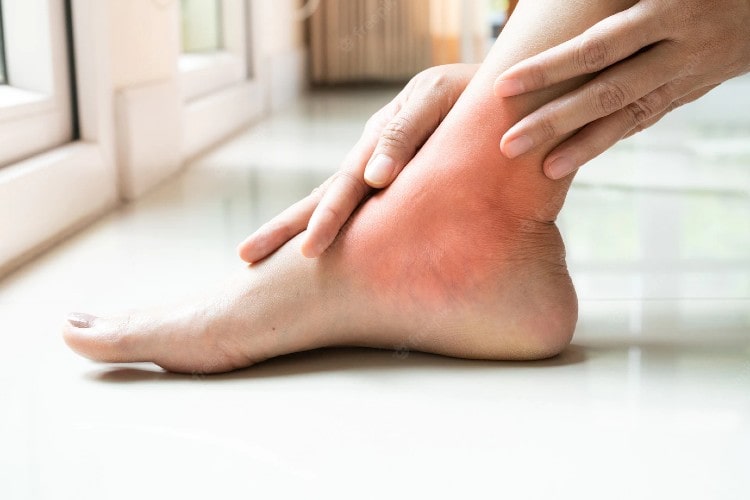
If you have been diagnosed with psoriatic arthritis, you may be wondering what symptoms of Psoriatic to expect and how to treat them. Psoriatic arthritis is a type of autoimmune disease that affects the joints, causing pain, stiffness and swelling.
Psoriatic arthritis (PsA) is a type of inflammatory arthritis that affects people with psoriasis. Up to 30 percent of people who have psoriasis will also develop PsA. The most common symptoms of PsA are pain, stiffness and swelling in your joints.
Psoriatic arthritis is the most common form of inflammatory arthritis, affecting up to 1.3 million people in the United States alone. In this blog post, we will discuss the most common symptoms of psoriatic arthritis and how to treat them.
If you have been diagnosed with psoriatic arthritis, you may be wondering what symptoms to expect and how to treat them. Psoriatic arthritis is a type of autoimmune disease that affects the joints, causing pain, stiffness and swelling. In this blog post, we will discuss the most common symptoms of psoriatic arthritis and how to manage them.
What is Psoriatic Arthritis?
Psoriatic arthritis (PsA) is a type of autoimmune disease that affects the joints, causing pain, stiffness, and swelling. It can also cause tendons and ligaments to become inflamed, as well as create tender spots where they join onto bones.
Psa usually affects people who have psoriasis, an inflammatory skin condition that causes redness, flaking, and itching. However, it is possible to have PsA without having psoriasis.
What are the symptoms of Psoriatic Arthritis?
The most common symptoms of psoriatic arthritis are pain, stiffness, and swelling in your joints. PsA may affect another joint in your body, and also create tender spots in the area tendons and ligaments join onto bones.
Other symptoms of psoriatic arthritis may include fatigue, swelling in fingers and toes, changes in the appearance of your nails, difficulty sleeping, and red, painful eyes. These physical symptoms will likely come and go and vary in severity as disease flares may alternate with periods of remission.
What are the first Signs of Psoriatic Arthritis
The first signs of psoriatic arthritis may be stiff, puffy fingers or toes and joint pain. Sometimes these symptoms happen together with tenderness in the same place on one’s hands/feet which is often followed by red skin patches that have silvery white scales formation due to excess cobwebs along their margins (this looks like very thin layer upon another).
ALSO Read: The #5 Best CBD Gummies for Pain, Inflammation, Anxiety, Stress and Better Sleep
8 Common Symptoms of Psoriatic Arthritis – May Be Mild or Severe
The symptoms of psoriatic arthritis can range from mild to severe, and they may come and go. If you are experiencing any symptoms of psoriatic arthritis, or how is psoriatic arthritis diagnosed?
It is important to see a doctor so that you can receive an accurate diagnosis and treatment plan. With the right treatment, you can manage your symptoms and prevent further damage to your joints.
If you have psoriatic arthritis, managing your symptoms is crucial to living a comfortable life. While there is no cure for PsA, understanding your symptoms is the first step in developing an effective management strategy.
Below is a detailed guide on eight common symptoms of psoriatic arthritis which include:
1. Psoriatic Arthritis Joint Pain
Joint pain is one of the most common symptoms of psoriatic arthritis. The pain can range from mild to severe, and it may come and go. PsA can affect any joint in your body, but it is most commonly found in the knees, ankles, and feet.
The joints of people with psoriatic arthritis may be red and warm to the touch, as well as painful. Unlike rheumatoid arthritis which usually affects both sides symmetrically this type of the condition is more likely seen only in one joint at a time rather than being distributed evenly throughout your body like most other forms.
2. Psoriatic Arthritis Pain That Flare-Up and Then Eases Off
Pain that worsens and then eases off is common in people who suffer from psoriasis. The pain may be constant or it can ease for periods before flare-ups happen again, just like how plaques on the skin occur with this condition; some patients even report feeling ankle stiffness at times which leads them to suspect arthritis could also develop there eventually if left untreated!
3. Psoriatic Arthritis Limit Free Joint Movement
With psoriatic arthritis, you may experience joint stiffness and reduced range of motion in your joints. This is due to inflammation that occurs when the skin becomes twitchy or sensitive because it’s trying desperately not to let out any more pain.
What feels necessary for healing purposes – which can lead some people experiencing these symptoms of psoriatic to move around only at night time so as avoid daytime discomfort associated with movement. However, once ongoing activity begins again (such as walking upstairs), most if not all soreness should dissipate rapidly
4. Psoriatic Arthritis Fingers and Toenail Pitting
With psoriatic arthritis, you may develop small round dents on the nails. Your fingers and toes might even lift away from their tips as a result of this condition which is usually diagnosed through symptoms including pitting or discoloration combined with others like pain in one spot rather than across multiple joints; it can also affect more than just hands/feet.
The nails of people who have psoriatic arthritis may become thick and pitted. The skin around their fingers or toes also becomes redder than normal, giving it a darker appearance similar to that seen in fungal infections; but you’ll need an accurate diagnosis from your doctor before assuming this condition is what’s wrong with you!
With psoriatic arthritis, you may notice that your nails are becoming thick and pitted. The small round dents in their surface can be seen by looking at the fingers or toes of those who have this condition as well – it’s not just about painful joints! These changes happen because skin cells build up on top causing an infection underneath which leads to white patches before spreading throughout other parts too; these fungal infections usually go away once treatment begins though so don’t worry too much if yours doesn’t seem quite right yet
5. Psoriatic Arthritis Resulting In Back Pain

Psoriatic arthritis can cause pain in the lower back, which may radiate down to your buttocks. This is ankylosing spondylitis – it affects bones at vertebrae and fuses them while causing severe inflammation there as well!
If you have psoriasis, your immune system may inflame the skin on its own. This can lead to arthritis and other inflammation-related symptoms like pain in joints or muscles; swelling due to either severe discomfort from touch sensitivity as well large sizes that are nonadjustable temporarily until they correct themselves over time but sometimes these changes will require medical attention because there’s no way for someone else tell what their condition might be without actually examining them first!
The vertebrae in our backs are constantly moving and changing, which can lead to a condition called ankylosing spondylitis. This type of arthritis affects the bones as they fuse causing pain down below from your lower back all the way through until you get its most severe symptoms–ollywoodfying towards either side!
6. Psoriatic Arthritis Swollen Fingers and Toe
If you have a swelling that covers your whole finger or toe, it could be psoriatic arthritis. This type of joint disease causes pain and stiffness in addition to the Pierre Robin sequence of symptoms of psoriatic like nails changing color from white/yellow to brown which is what we see with rheumatoid sufferers too!
The pain of rheumatoid arthritis is typically felt only at the joints, but psoriatic swelling can be present throughout your fingers and toes. The sausage-like shape may help distinguish between these two conditions as it will show up in more than one place on any given day!
7. Psoriatic Arthritis Resulting in Foot Pain

Many different types of arthritis can affect your joints. One type, psoriatic arthritis is often mistaken for plantar fasciitis or tennis elbow because it only affects certain areas and not others like these other conditions usually do–but there could be something seriously wrong if you’re experiencing pain in more than one place!
The heel and elbow are two of the most common joints to be affected by psoriatic arthritis. The enthesitis that this condition causes can cause pain in those areas, as well as plantar fasciitis or tennis elbow when it affects them too much; however if you have just minor discomfort from your feet upwards towards their fingers then there might not even need an appointment with our doctor!
8. Psoriatic Arthritis Red Eyes or Irritated
With psoriatic arthritis, you may experience eye inflammations. Your vision can become blurry and painful eyes are common among sufferers of this condition which could be caused by the skin disease’s proximity to your eyelid crease – so keep those blinkers on!
There are several different types and stages in the development of both eyes that can be inflamed due to psoriatic arthritis. Your vision may become blurry or painful, which could lead to an inflammation called iritis as well if you suffer from this condition long enough!
The signs of psoriatic arthritis can be difficult to diagnose because they often overlap with other common skin diseases. One clue that may point towards this diagnosis is an inflammation in your eyes, either conjunctivitis or iritis. Your vision might also become blurry and painful if you have a swollen eyelid sac called “psoriasis.”
Do you have psoriatic arthritis? What symptoms of psoriatic are you experiencing? Leave a comments below.
How is Psoriatic Arthritis treated?
There is no cure for psoriatic arthritis, but there are treatments that can help to manage the symptoms of psoriatic and prevent further damage to the joints. Common treatments include anti-inflammatory medications, pain relievers, corticosteroids, disease-modifying antirheumatic drugs (DMARDs), and biologic agents. In some cases, physical therapy or surgery may also be recommended.
Related Psoriatic Arthritis Treatment – Symptoms, medication, Foods, Ultimate Guide
What happens if psoriatic arthritis is left untreated?
What are the 5 types of psoriatic arthritis?
The five types of psoriatic arthritis are distal interphalangeal, asymmetric oligoarticular (a few small joints), symmetric polyarthritis(which affects more than one joint) psoriasis arthritis, spondylitis and ankylosing regenerative knitting itself into a solid mass called amyd communicating canal intermediatetype which can be painful if it’s located near tendons or nerves.
The five types of psoriatic arthritis are distal interphalangeal predominant, asymmetric oligoarticular (which mainly affects the ends fingers and toes), symmetric polyarthritis.
Spondylitis is an inflammation that produces pain in your spine while arthritis mutilans has no clear trigger or cause but occurs most often between ages 15-35 years old males due to their increased risk factor being genetic background leading them towards developing more severe forms over time if left untreated before presenting symptoms of psoriatic such as joint Palace popularity among athletes who participate heavily.
Conclusion:
People who have had previous experience with these symptoms of psoriatic should always visit their doctor immediately because there is currently no known cure available yet.













